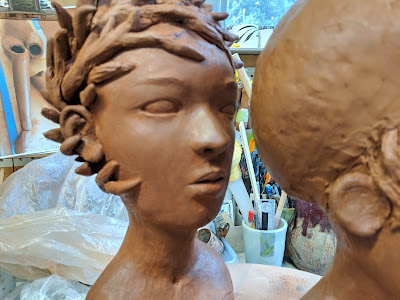Boxed Woods pt 2: Or how to make a slab box with one piece of paper


- Use one sheet of cheap printer paper or any light weight sheet of paper about 8" x 10".
- Draw 2" border. This is the body of the box---consisting of sides and bottom.
- Draw 1/2" border on the outside of inner rectangle. This is the pattern for the top and lid.
- Have at least three slabs ready. Minimum size 9"x 12". Between 3/8"-1/2" thick. No thinner. No thicker.
- The first slab needs to remain soft and have its own board. It will be cut and form on this board.
- The other two slabs can rest on another wood board or sheetrock. These will need to set up a little longer to leatherhard.
 |



Use a roller of some sorts to compress sides flat. It helps to sharpen the corners, too. Scraping the the sides works, too. I leave the bottom edge alone. This keeps it from looking overworked. Besides, I like its soft and rounded edges. Once the feet goes on it even looks nicer.
Place pattern over leather-hard slab. I went over the lines again so the top is more apparent. Impress markings for top and lid. Remove pattern and trim away outer lines of rectangle.
Make sure that it fits over the top of the box. A little bit of overhang is just right. Now it's time to cut out the lid. For a beveled edge I use a good old fashioned wooden rule with a metal strip and an craft knife.
The lid and top opening is now done. For the flange I make a smaller frame than the opening and attach underneath. Strips of slab can also be used. The bevel edge is mostly decorative and a small flange is necessary to keep the lid from falling in just in case it shrinks in the firing. It looks nice, too.

 |
| top frame is the flange, big frame is the top, solid piece is the lid |

Inside flange now attached
TA DAH!
One little box filled with surprises!













This is fabulous - and you make it all look so easy! I have printed it out and now (patiently) waiting for my clay area to be set-up. I really like the sig/drawing on the inside.
ReplyDeleteThanks!
It really is easy. You'll see...It eliminates 4 seams. Less cutting. Less parts to score/slip. Let me know how yours turns out! Thanks, Judy........: )
DeleteThanks for sharing your box-making techniques with us, Charlene. A very interesting article, and beautifully presented. I especially like the way you fashioned the lid, and the way you have left the clay un-glazed, it really suits the form.
ReplyDeleteYou're welcome, Mark. I love seeing other people's process and find it so enjoyable and inspirational. I still can watch anyone throwing or pinching a simple pot with great fascination and enjoyment! This was my way of sharing that same involvement when working with clay.
Deletethis is a great instructional piece, if folks who purchase pottery saw this they'd appreciate all the work which goes into making pieces so much more.
ReplyDeleteYou are making me smile, Linda.
Delete